Socio-Economic Considerations of Converting Food Waste into Biogas on a Household Level in Indonesia: The Case of the City of Bandung
Abstract
:1. Introduction
2. The Theoretical and Contextual Framework
2.1. Biogas Production from Food Waste
2.2. Economic Feasibility
2.3. Social Acceptance
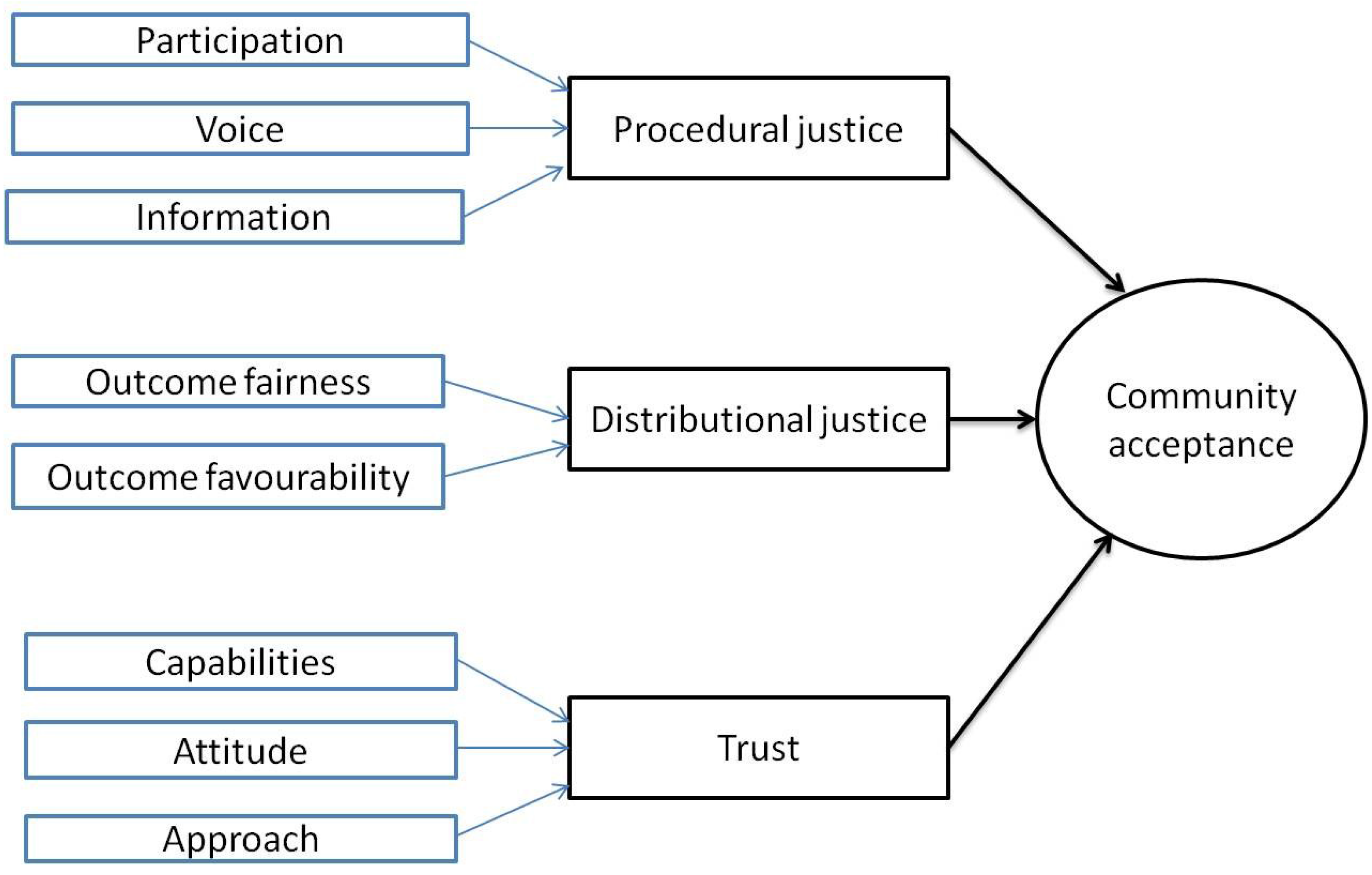
3. Research Location and Methods
3.1. Location and Description of the Studied Case
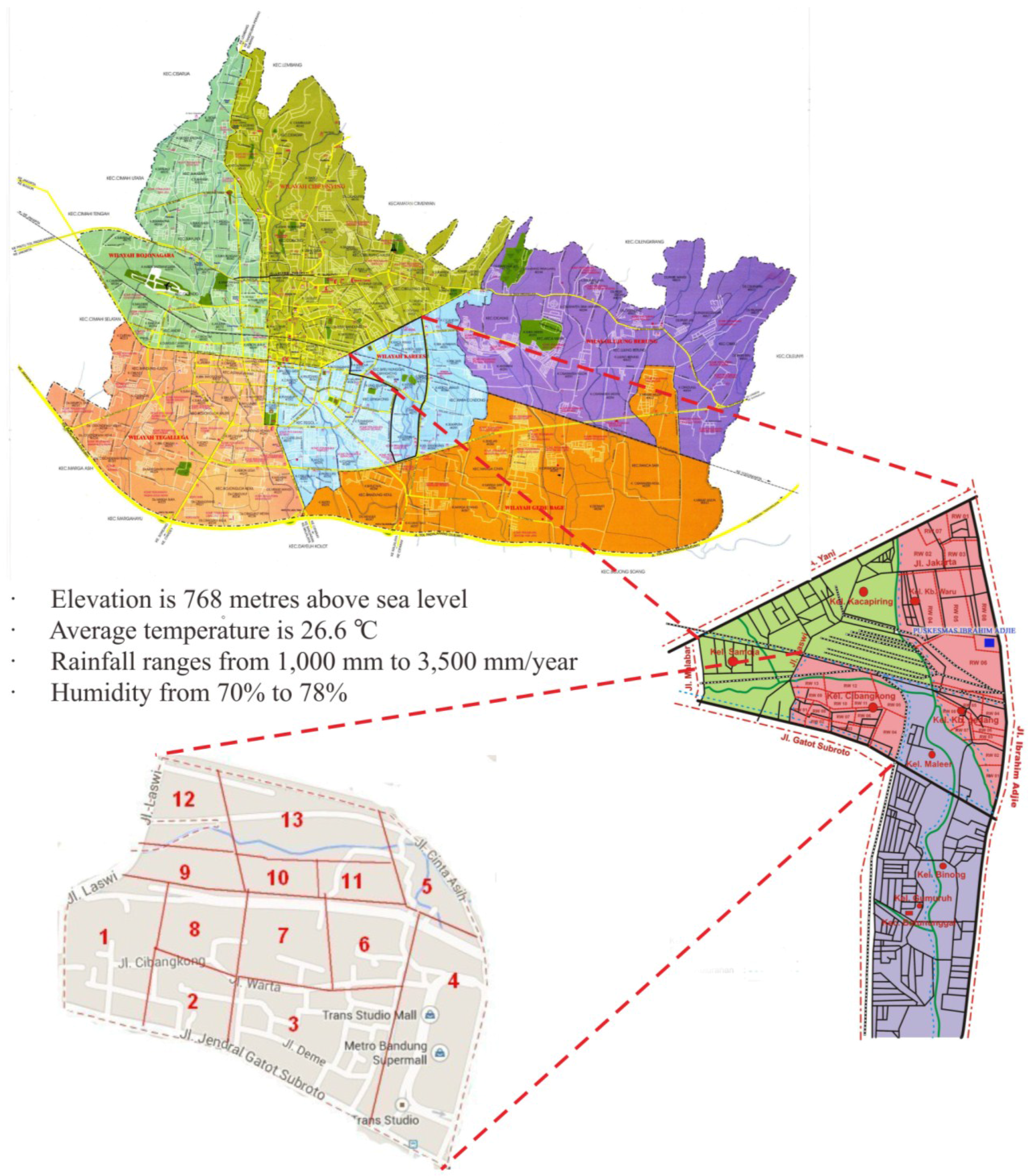
3.1.1. RW 8

3.1.2. RW 11
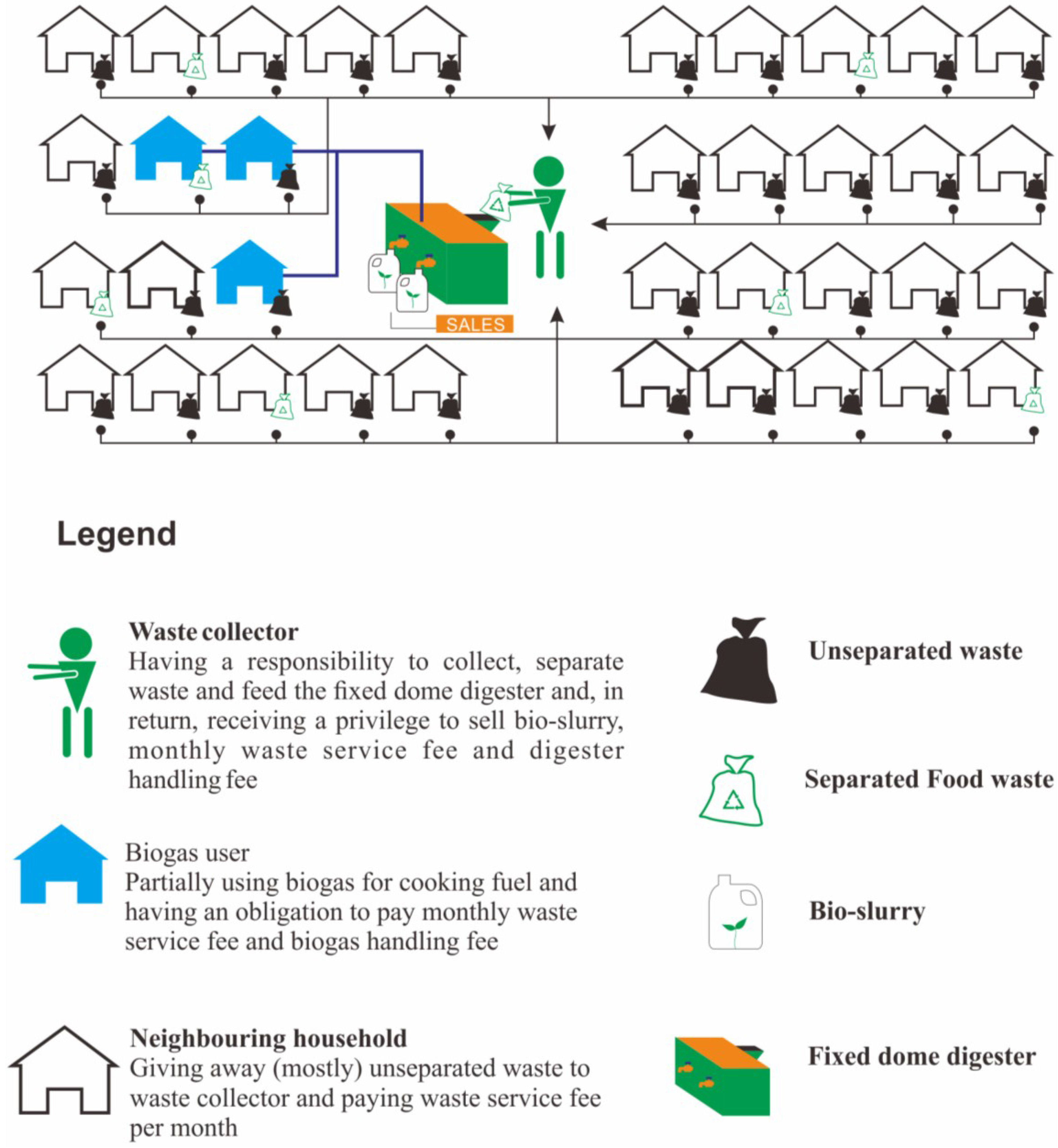
3.2. Research Methods
- NPV = Net Present Value
- Ab = Annual benefits
- Ac = Annual operating costs
- i = Interest rate
- t = Life time of the plant
- C = Cost of the bio-digester
| RW | Target Group | Number of Population | Sampling Method | Number of Sample |
|---|---|---|---|---|
| 8 | Bio-digester owners | 3 | Census | 3 F |
| Neighboring households | 23 | Census | 23 F | |
| Heads of several local institutions | 3 | Purposive sampling | 3 F | |
| 11 | Biogas users in RW 11 | 3 | Census | 3 F |
| Local waste officer in RW 11 | 1 | Census | 1 M | |
| Neighboring households in RW 11 | 109 | Random sampling | 86 (81 F + 5 M) | |
| Heads of several local institutions | 3 | Purposive sampling | 2 F + 1 M | |
| TOTAL | 115 F +7 M | |||
4. Results and Discussion
4.1. Economic Feasibility
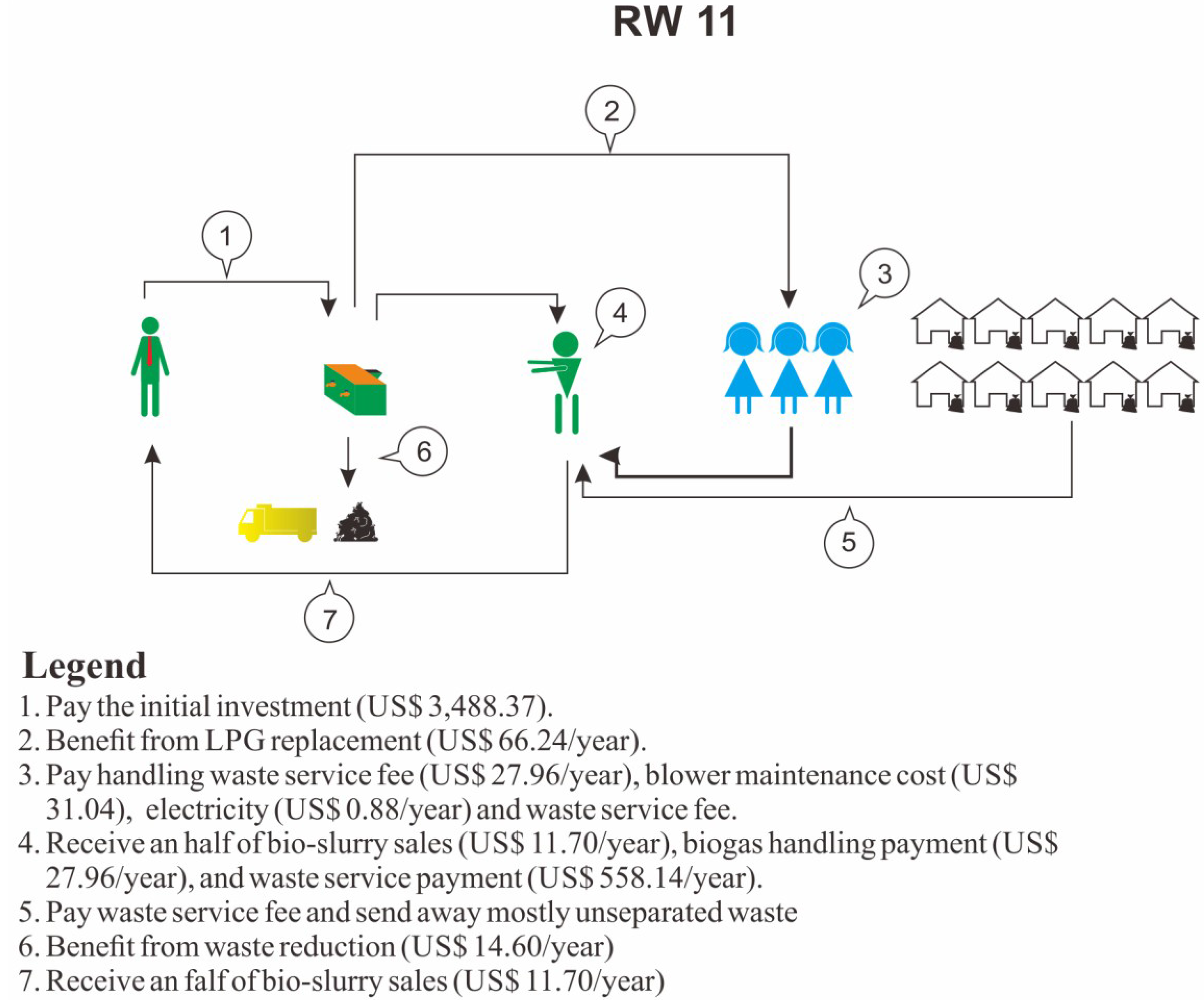

RW 11
| RW | Variable | Details | Unit Price | Amount | Total |
|---|---|---|---|---|---|
| 11 | Initial investment | Digester cost | US $ 3488.37 | 1 unit | US $ 3488.37 |
| Installation cost | |||||
| Transportation cost | |||||
| Total Initial Investment | US $ 3488.37 | ||||
| Annual cost | Maintenance cost | US $ 3.88/blower | 8 blowers/year | US $ 31.04/year | |
| Operational cost | US $ 2.33/month | 12 months/year | US $ 27.96/year | ||
| Depreciation | US $ 3488.37/digester | 1 digester/20 years | US $ 174.42/year | ||
| Electricity | US $ 0.05/kWh | 17.52 kWh/year | US $ 0.88/year | ||
| Total Annual Cost | US $ 234.30/year | ||||
| Annual benefits (best-case scenario) | LPG replacement | US $ 0.46/kg | 144 kg/year | US $ 66.24/year | |
| Bio-slurry sales | US $ 0.78/L | 4800 L/year | US $ 3744.00/year | ||
| Waste reduction | US $ 0.50/m3 | 29.2 m3/year | US $ 14.60/year | ||
| Total Annual Benefits | US $ 3824.84/year | ||||
| Annual Benefits (actual situation) | LPG replacement | US $ 0.46/kg | 144 kg/year | US $ 66.24/year | |
| Bio-slurry sales | US $ 0.78/L | 30 L/year | US $ 23.40/year | ||
| Waste reduction | US $ 0.50/m3 | 29.2 m3/year | US $ 14.60/year | ||
| Total Annual Benefits | US $ 104.24/year | ||||
| 8 | Initial investment | Digester cost | US $ 736.43 | 1 unit | US $ 736.43 |
| Installation cost | |||||
| Transportation cost | |||||
| Total Initial Investment | US $ 736.43 | ||||
| Annual cost | Maintenance cost | US $ 3.88/blower | 2 blowers/year | US $ 7.76/year | |
| Operational cost | - | - | - | ||
| Depreciation | US $ 736.43/digester | 1 digester/10 years | US $ 73.64/year | ||
| Electricity | US $ 0.05/kWh | 4.38 kWh/year | US $ 0.22/year | ||
| Total Annual Cost | US $ 81.62/year | ||||
| Annual benefits (best-case scenario) | LPG replacement | US $ 0.46/kg | 36 kg/year | US $ 16.56/year | |
| Bio-slurry sales | US $ 0.78/L | 1200 L/year | US $ 936.00/year | ||
| Waste reduction | US $ 0.50/m3 | 7.7 m3/year | US $ 3.85/year | ||
| Total Annual Benefits | US $ 956.41/year | ||||
| Annual Benefits (actual situation) | LPG replacement | US $ 0.46/kg | 36 kg/year | US $ 16.56/year | |
| Bio-slurry sales | US $ 0.78/L | 8 L/year | US $ 6.24/year | ||
| Waste reduction | US $ 0.50/m3 | 7.7 m3/year | US $ 3.85/year | ||
| Total Annual Benefits | US $ 26.65/year | ||||
| RW | Scenario | Variable | LPG Price | Unit | Annual Benefit | NPV | Sensitivity |
|---|---|---|---|---|---|---|---|
| 11 | Current situation | LPG replacement | US $ 0.46/kg | 144 kg/year | US $ 66.24/year | −US $4814.27 | - |
| Bio-slurry sales | US $ 0.78/L | 30 L/year | US $ 23.40/year | ||||
| Technical improvement and LPG policy reform | LPG replacement | US $ 1.00/kg | 576 kg/year | US $ 576/year | US $382.48 | 0.14 | |
| Market support | Bio-slurry sales | US $ 0.78/L | 2400 L/year | US $ 1872.00/year | US $14,031.27 | 0.05 | |
| 8 | Current situation | LPG replacement | US $ 0.46/kg | 36 kg/year | US $ 16.56/year | −US $1113.75 | - |
| Bio-slurry sales | US $ 0.78/L | 8 L/year | US $ 6.24/year | ||||
| Technical improvement and LPG policy reform | LPG replacement | US $ 1.00/kg | 144 kg/year | US $ 144/year | −US $238.99 | 0.1 | |
| Market support | Bio-slurry sales | US $ 0.78/L | 600 L/year | US $ 468.00/year | US $2055.81 | 0.04 |
4.2. Social Acceptance
4.2.1. Gender Disaggregated Data
| No | Gender Aspect | RW 8 | RW 11 | ||||||
|---|---|---|---|---|---|---|---|---|---|
| N | M (%) | F (%) | I | N | M (%) | F (%) | I | ||
| 1 | Population | 1552 | 52.4% | 47.6% | - | 2938 | 50% | 50% | - |
| 2 | Illiteracy | 8 | 37.5% | 62.5% | 1.7 | 36 | 55.6% | 44.4% | 0.8 |
| 3 | Not enrolled in primary education | 8 | 37.5% | 62.5% | 1.7 | 40 | 62.5% | 37.5% | 0.6 |
| 4 | Inability to make decision 1 | - | 52.4% | 47.6% | 0.9 | - | 27.9% | 72.1% | 2.6 |
| 5 | Economic inactivity | 543 | 21.6% | 78.4% | 3.6 | 1271 | 10.0% | 90.0% | 9 |
| 6 | Income difference | - | 91.4% | 8.6% | - | - | 94.6% | 5.4% | - |
| 7 | Total aggregated index | 2.0 | 3.2 | ||||||
| Roles (Scoping Cibangkong Areas) | Gender Domination |
|---|---|
| Household | |
| Men |
| Women |
| Men |
| Women |
| Women |
| Women |
| Women |
| Men |
| Men |
| Women |
| Men |
| Women |
| Women |
| Women |
| Community | |
| Women |
| Men |
| Women |
| Women |
| Men |
| Women |
| Men |
4.2.2. Community Acceptance
| No | Aspect | Parameter | RW 8 | RW 11 |
|---|---|---|---|---|
| 1 | Procedural justice | Participation | Almost all representatives participated | Lack of participation from local officials |
| Voice | Positive responses | A mix between, negative, neutral and positive responses | ||
| Information | Positive responses | Positive responses | ||
| 2 | Distributional justice | Outcome fairness | Positive reviews | Lack of willingness to share burden |
| Outcome favorability | Favorable: biogas, bio-slurry, LPG saving. Not favorable: fluctuated biogas, bad smell from bio-digester. Easily broken blower | Favor toward: biogas, bio-slurry, LPG saving. Not favor: fluctuated biogas, easily broken blower, low salary, lack of support to promote bio-slurry to the markets, unseparated waste (mainly experienced by local waste collector) | ||
| 3 | Trust | Capabilities | Positive responses | A mix between neutral and positive responses |
| Attitude | Positive responses | Positive responses | ||
| Approach | Positive responses | Positive responses |
RW 8
RW 11
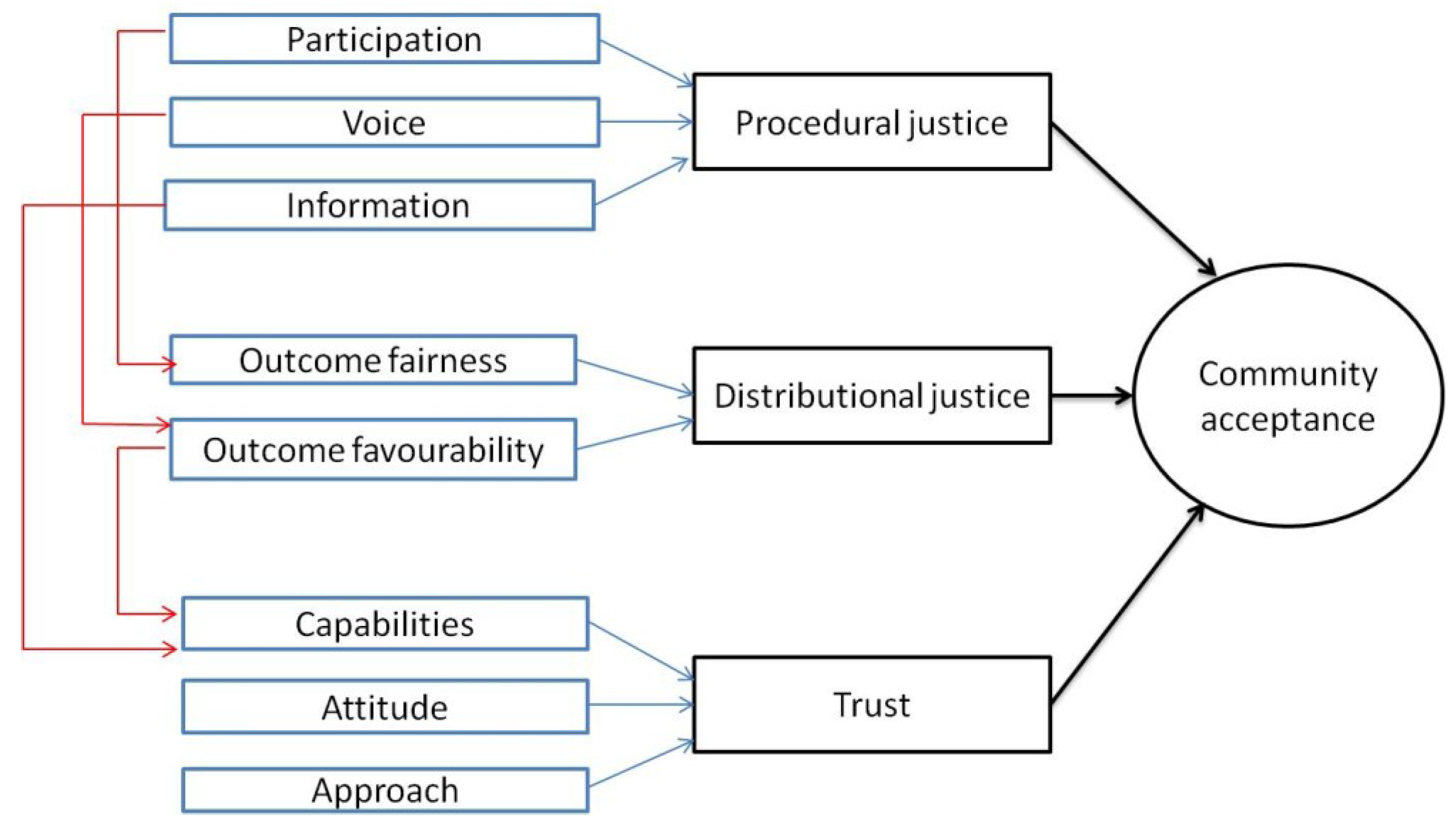
5. Conclusions
- It will be beneficial to seek technical improvement regarding biogas production and utilization it to reach its potential application, especially in replacing LPG as a cooking fuel and increasing community acceptance for this waste management strategy.
- Adequate support for bio-slurry to penetrate the market is recommended. It also opens an opportunity to further assess the demand and market condition of the bio-slurry to provide solutions to these problems.
- Based on the study of community acceptance, establishing procedural justice seems to be very important. Thus, promoting better participation and considering minority voice to guarantee a fair outcome is advised.
- Involvement of women—mainly in charge of waste management, seems to be very important in increasing successful implementation and social acceptance. Improving cooperation by local women is thus advised.
- When introducing larger scale bio-digesters as the measures to reduce food waste, more effort may be needed to ensure higher levels of acceptance by local women in participating households, such as community education programs for waste separation at the source, more involvement by community leaders, and better compensation for the communal waste collectors.
Acknowledgments
Author Contributions
Conflict of Interest
References
- Indonesian Ministry of Environment. Environmental Status of Indonesia; Indonesian Ministry of Environment: Jakarta, Indonesia, 2008. [Google Scholar]
- Yachiyo Engineering Co., Ltd. Study For. Integrated Environmental Improvement of Leuwigajah. Disposal Site in West Java, Republic of Indonesia; Yachiyo Engineering Co., Ltd.: Bandung, Indonesia, 2009. [Google Scholar]
- Indonesian Ministry of Environment. Indonesian Domestic Solid Waste Statistics; Indonesian Ministry of Environment: Jakarta, Indonesia, 2008. [Google Scholar]
- Chaerul, M.; Tanaka, M.; Shekdar, A.V. Municipal Waste Management in Indonesia: Status and the Strategic Actions. J. Fac. Environ. Sci. Technol. 2007, 69, 41–49. [Google Scholar]
- Ismaria, R. Studi Mekanisme dan Interaksi Daur-Ulang Terhadap Sistem Pengelolaan Sampah Dengan Pengembangan Model Dinamik—Studi Kasus Kotamadya Bandung. Master’s Thesis, Institut Teknologi Bandung, Jawa Barat, Indonesia, 2000. [Google Scholar]
- Safitri, M.; Fujiwara, T.; Chaerul, M.; Damanhuri, E. The 25rd Annual Conference of Japan Society of Material Cycles and Waste Management; Japan Society of Material Cycles and Waste Management: Tokyo, Japan, 2014; pp. 579–580. [Google Scholar]
- Sundana, E.J. Solid Waste Management Services in Bandung Municipality: Status of Financial and Cost Recovery. In Proceedings of Financing and Cost Recovery for the Provision of Urban Environmental Infrastructure Services, Asian Institute of Technology, Bangkok, Thailand, 13–15 December 2004.
- Damanhuri, E.; Padmi, T. ISWA International Symposium on Waste Management in Asia Cities; International Solid Waste Association: Vienna, Austria, 2000. [Google Scholar]
- Indonesian Ministry of Energy and Mineral Resources. Indonesia Energy Outlook 2013; Indonesian Ministry of Energy and Mineral Resources: Jakarta, Indonesia, 2013. [Google Scholar]
- Business Competition Supervisory Commission of Indonesia. Background Paper: Policy Analysis on LPG Industry Competition in Indonesia; Business Competition Supervisory Commission of Indonesia: Jakarta, Indonesia, 2010. [Google Scholar]
- Paglia, T.K. Energy Improvement Districts and Local Energy Production. Master’s Thesis, Cornell University, Ithaca, NY, USA, 2011. [Google Scholar]
- Indonesia Domestic Biogas Programme. Biogas Rumah. Annual Report 2010; Indonesia Domestic Biogas Programme: Jakarta, Indonesia, 2010. [Google Scholar]
- Al Seadi, T.; Rutz, D.; Janssen, R.; Drosg, B. Biomass resources for biogas production. In The Biogas Handbook: Science, Production and Application; Wellinger, A., Murphy, J., Baxter, D., Eds.; Woodhead Publishing Limited: Cambridge, UK, 2013; pp. 19–51. [Google Scholar]
- Petersson, A. Biogas cleaning. In The Biogas Handbook: Science, Production and Application; Wellinger, A., Murphy, J., Baxter, D., Eds.; Woodhead Publishing Limited: Cambridge, UK, 2013; pp. 329–341. [Google Scholar]
- Kubaská, M.; Sedláˇcek, S.; Bodík, I.; Kissová, B. Proceedings of the 37th International Conference of Slovak Society of Chemical Engineering; Slovak Society of Chemical Engineering: Tatranské Matliare, Slovakia, 2010; pp. 1413–1418.
- Svenskt Gastekniskt Center. Basic Data on Biogas; Svenskt Gastekniskt Center: Malmo, Sweden, 2012. [Google Scholar]
- Murphy, J.D.; Thamsiriroj, T. Fundamental science and engineering of the anaerobic digestion process for biogas production. In The Biogas Handbook: Science, Production and Application; Wellinger, A., Murphy, J., Baxter, D., Eds.; Woodhead Publishing Limited: Cambridge, UK, 2013; pp. 104–130. [Google Scholar]
- Rajendran, K.; Aslanzadeh, S.; Johansson, F.; Taherzadeh, M.J. Experimental and economical evaluation of a novel biogas digester. Energy Convers. Manag. 2013, 74, 183–191. [Google Scholar] [CrossRef]
- Muller, C. Anaerobic Digestion of Biodegradable Solid Waste in Low- and Middle-Income Countries: Overview over Existing Technologies and Relevant Case Studies; Swiss Federal Institute of Aquatic Science and Technology: Dübendorf, Switzerland, 2007. [Google Scholar]
- Muryanto, A.H.; Muntoha, D.W. Indonesian Rekomendasi Teknologi Instalasi Biogas Drum Skala Rumah Tangga; Balai Pengkajian Teknologi Pertanian Jawa Tengah: Semarang, Indonesia, 2008. [Google Scholar]
- Nzila, C.; Dewulf, J.; Spanjers, H.; Tuigong, D.; Kiriamiti, H.; van Langenhove, H. Multi criteria sustainability assessment of biogas production in Kenya. Appl. Energy 2012, 93, 496–506. [Google Scholar] [CrossRef]
- Smith, J.U. The Potential of Small-Scale Biogas Digesters to Alleviate Poverty and Improve Long Term Sustainability of Ecosystem Services in Sub-Saharan Africa; Department for International Development: London, UK, 2011. [Google Scholar]
- Herero, J.M.; Chipana, M.; Cuevas, C.; Paco, G.; Serrano, V.; Zymla, B.; Heising, K.; Sologuren, J.; Gamara, A. Low cost tubular digesters as appropriate technology for widespread application: Results and lessons learned from Bolivia. Renew. Energy 2014, 71, 156–165. [Google Scholar] [CrossRef]
- Kayhanian, M.; Hardy, S. The impact of 4 design parameters on the performance of a high-solids anaerobic digestion process of municipal solid waste for fuel gas production. Environ. Technol. 1994, 15, 557–567. [Google Scholar] [CrossRef]
- Howard, P.; Pinel, S. Project 2: Engineers Without Borders Challenge; Engineers Without Borders Australia: North Melbourne, Australia, 2011. [Google Scholar]
- Haque, N. International Workshop on Financing of Domestic Biogas Plants; Stichting Nederlandse Vrijwilligers: Amsterdam, the Netherlands, 2008. [Google Scholar]
- Dhakal, H.N. Financing Domestic Biogas Plants in Nepal; Stichting Nederlandse Vrijwilligers: Kathmandu, Nepal, 2008. [Google Scholar]
- Estoppey, N. Evaluation of Small-Scale Biogas Systems for the Treatment of Feces and Kitchen Waste: Case Study Kochi, South India; Swiss Federal Institute of Aquatic Science and Technology: Dübendorf, Switzerland, 2010. [Google Scholar]
- Vij, S. Biogas Production From Kitchen Waste & to Test the Quality and Quantity of Biogas Produced from Kitchen Waste Under Suitable Conditions. Bachelor’s Thesis, National Institute of Technology Rourkela, Odisha, India, 2011. [Google Scholar]
- Bala, B.K.; Hossain, M.M. Economics of biogas digesters in Bangladesh. Energy 1991, 17, 939–944. [Google Scholar] [CrossRef]
- Kandpal, T.C.; Joshi, B.; Sinha, C.S. Economics of family sized biogas plants in India. Energy Convers. Manag. 1991, 32, 101–113. [Google Scholar] [CrossRef]
- Adeoti, O.; Ilori, M.O.; Oyebisi, T.O.; Adekoya, L.O. Engineering design and economic evaluation of a family-sized biogas project in Nigeria. Technovation 2000, 20, 103–108. [Google Scholar] [CrossRef]
- Brealey, R.; Myers, S.; Allen, F.; Geis, G. Principles of Corporate Finance, 10th ed.; The McGraw-Hill: Boston, MA, USA, 2011. [Google Scholar]
- Ross, S.A.; Westerfield, R.W.; Jaffe, J. Modern Financial Management, 8th ed.; The McGraw-Hill: New York, NY, USA, 2009. [Google Scholar]
- Mindlin, D. Present Values, Investment Returns and Discount Rates; CDI Advisors LLC: Oak Park, CA, USA, 2013. [Google Scholar]
- Young, L. Determining the Discount Rate for Government Projects; New Zealand Treasury: Wellington, New Zealand, 2002. [Google Scholar]
- Wustenhagen, R.; Wolsink, M.; Burer, M.J. Social acceptance of renewable energy innovation: An introduction to the concept. Energy Policy 2007, 34, 2683–2691. [Google Scholar] [CrossRef]
- United Nations Environment Programme. Municipal Waste Management Report: Status-Quo and Issues in Southeast and East Asian Countries; United Nations Environment Programme: Washington, New Zealand, 2010. [Google Scholar]
- Dowall, D.E.; Clark, G. A Framework for Reforming Urban Land Policies in Developing Countries; The International Bank for Reconstruction and Development of The World Bank: Washington, New Zealand, 1996. [Google Scholar]
- Schienberg, A.; Muller, M.; Tasheva, E.L. Gender and Waste; WASTE: Gouda, The Netherland, 1999. [Google Scholar]
- Lipinski, B.; Hanson, C.; Lomax, J.; Kitinoja, L.; Waite, R.; Searchinger, T. Reducing Food Loss and Waste; World Resources Institute: Washington, DC, USA, 2013. [Google Scholar]
- Lind, E.; Tyler, T. The Social Psychology of Procedural Justice; Plenum Press: New York, NY, USA, 1988. [Google Scholar]
- Deutsch, M. Justice and Conflict. In The Handbook of Conflict Resolution: Theory and Practice; Deutsch, M., Coleman, P.T., Eds.; Jossey-Bass: San Francisco, CA, USA, 2000; pp. 41–64. [Google Scholar]
- Gross, C. Community perspectives of wind energy in Australia: The application of a justice and community fairness framework to increase social acceptance. Energy Policy 2007, 35, 2727–2736. [Google Scholar] [CrossRef]
- Greenberg, J. Stealing in the name of justice: Informational and interpersonal moderators and theft reactions to underpayment inequity. Organ. Behav. Hum. Decis. Processes 1993, 54, 81–103. [Google Scholar] [CrossRef]
- MacCoun, R.J. Voice, control, and belonging: The double-edged sword of procedural fairness. Annu. Rev. Law Soc. Sci. 2005, 1, 171–201. [Google Scholar] [CrossRef]
- Vermunt, R.; Törnblom, K.Y. Introduction: Distributive and procedural justice. Soc. Justice Res. 1996, 9, 305–311. [Google Scholar] [CrossRef]
- Van der Horst, D. NIMBY or not? Exploring the relevance of location and the politics of voiced opinions in renewable energy siting controversies. Energy Policy 2007, 35, 2727–2736. [Google Scholar] [CrossRef]
- Skitka, L.J.; Winquist, J.; Hutchison, S. Are outcome fairness and outcome favorability distinguishable psychological constructs? A meta-analytic review. Soc. Justice Res. 2003, 16, 309–341. [Google Scholar] [CrossRef]
- Huijts, N.M.A.; Midden, C.J.H.; Meijnders, A.L. Public acceptance of carbon dioxide storage. Energy Policy 2007, 35, 2780–2789. [Google Scholar] [CrossRef]
- Gebreegziabher, Z.; Naik, L.; Melamu, R.; Balana, B.B. Prospects and challenges for urban application of biogas installations in Sub-Saharan Africa. Biomass Bioenergy 2014, 30, 1–11. [Google Scholar] [CrossRef]
- Singh, A.; Sevnsson, J.; Kaylanpur, A. The state of sex-disaggregated data for assessing the impact of climate change. Procedia Environ. Sci. 2010, 1, 395–404. [Google Scholar] [CrossRef]
© 2015 by the authors; licensee MDPI, Basel, Switzerland. This article is an open access article distributed under the terms and conditions of the Creative Commons Attribution license (http://creativecommons.org/licenses/by/4.0/).
Share and Cite
Amir, E.; Hophmayer-Tokich, S.; Kurnani, T.B.A. Socio-Economic Considerations of Converting Food Waste into Biogas on a Household Level in Indonesia: The Case of the City of Bandung. Recycling 2016, 1, 61-88. https://doi.org/10.3390/recycling1010061
Amir E, Hophmayer-Tokich S, Kurnani TBA. Socio-Economic Considerations of Converting Food Waste into Biogas on a Household Level in Indonesia: The Case of the City of Bandung. Recycling. 2016; 1(1):61-88. https://doi.org/10.3390/recycling1010061
Chicago/Turabian StyleAmir, Encep, Sharon Hophmayer-Tokich, and Tubagus Benito Achmad Kurnani. 2016. "Socio-Economic Considerations of Converting Food Waste into Biogas on a Household Level in Indonesia: The Case of the City of Bandung" Recycling 1, no. 1: 61-88. https://doi.org/10.3390/recycling1010061
APA StyleAmir, E., Hophmayer-Tokich, S., & Kurnani, T. B. A. (2016). Socio-Economic Considerations of Converting Food Waste into Biogas on a Household Level in Indonesia: The Case of the City of Bandung. Recycling, 1(1), 61-88. https://doi.org/10.3390/recycling1010061





